Choosing the Best Canon Real Estate Lens depends on several factors, including the type of Canon camera you have (full-frame or APS-C), your budget, and specific photography needs. Here’s a breakdown of the approach and considerations for selecting the ideal lens:
- Wide-Angle Lens: For real estate photography, a wide-angle lens is essential. It allows you to capture expansive interior and exterior shots, making spaces appear larger and more inviting.
- Lens Distortion: While wide-angle lenses are great for capturing more of the scene, they can also introduce distortion. Look for lenses that offer minimal distortion or lenses for which distortion can be easily corrected in post-processing.
- Aperture: A lens with a wide aperture (low f-number) is not as crucial in real estate photography as it is in other types of photography because you’ll often be shooting in well-lit conditions or using a tripod. However, a good aperture can help in low light conditions.
- Autofocus and Image Stabilization: Fast autofocus is beneficial but not a deal-breaker since real estate photography often involves static scenes. Image stabilization is a nice feature but also not essential if you’re using a tripod.
Table of Contents
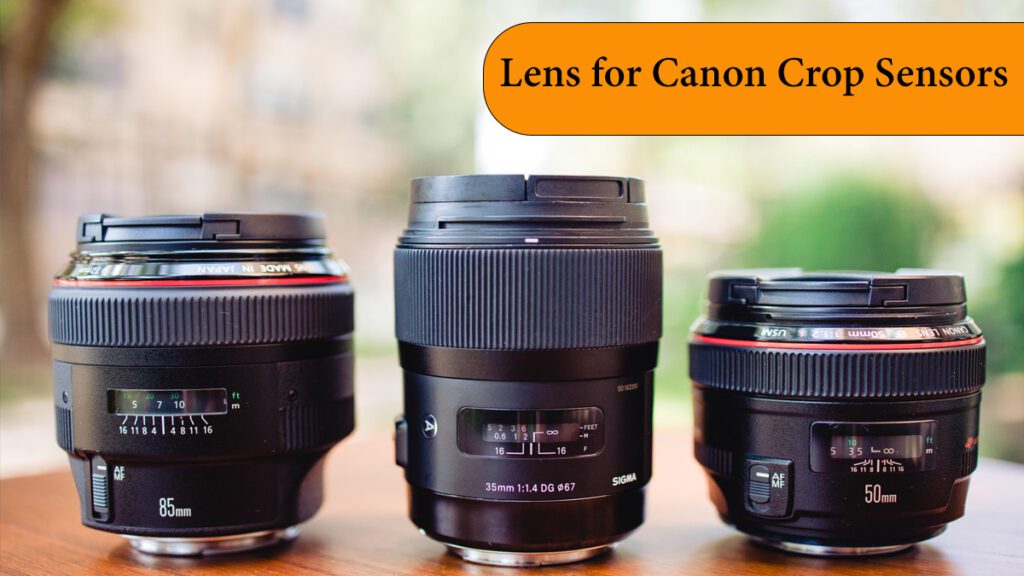
Must Have to Have Features For Best Canon Real Estate Lens
For real estate photography, certain lens features are particularly important to ensure you capture properties in their best light. Here are the “must-have” features to look for in a real estate photography lens:
- Wide-Angle Range: Essential for capturing tight spaces and making rooms appear more spacious. Look for lenses with a focal length of:
- Full-Frame Cameras: 16-35mm range.
- APS-C Cameras: 10-22mm range (equivalent to approximately 16-35mm on a full-frame due to the crop factor).
- Minimal Distortion: While wide-angle lenses can introduce distortion, causing straight lines to appear curved, some lenses are designed to minimize this effect. Lenses with low distortion are preferable, as they reduce the amount of post-processing needed to correct these distortions.
- Sharpness: The lens should produce sharp images with good edge-to-edge clarity. Sharpness is crucial for showcasing the details of a property, from the textures of materials to the intricacies of design.
- Autofocus Performance: While not as critical as for other photography genres since real estate subjects are static, a lens with reliable and accurate autofocus ensures sharp images and can speed up the shooting process.
- Build Quality and Reliability: Real estate photography can involve a lot of travel and changing environments. A durable lens that can withstand regular use is important.
- Image Stabilization: Although not a strict necessity if you’re using a tripod, image stabilization can be very helpful for handheld shots, especially in low light conditions or when shooting real estate videos.
- Aperture: A lens with a wider maximum aperture (lower f-number) isn’t as crucial in real estate photography as in other types. However, a decent aperture can still be beneficial for natural light shots and achieving a shallow depth of field when desired.
Optional but Beneficial Features:
- Tilt-Shift Capabilities: Tilt-shift lenses allow for perspective control, enabling the photographer to correct converging vertical lines – a common issue in architectural photography. While not a must-have, this feature can elevate the quality of your real estate photos.
- Weather Sealing: If you often shoot in various weather conditions, weather sealing can protect your lens from dust, moisture, and other environmental factors.
Final Answer:
The must-have features for a real estate photography lens include a wide-angle range to capture tight spaces, minimal distortion to ensure straight lines remain straight, excellent sharpness for detail clarity, reliable autofocus for convenience, durable build quality for regular use, and optionally, image stabilization for handheld shooting. While a wide aperture and special features like tilt-shift are beneficial, they are not strictly necessary for producing high-quality real estate photographs.
Top Canon Lenses for Real Estate Photography:
1.Canon EF 11-24mm f/4L USM
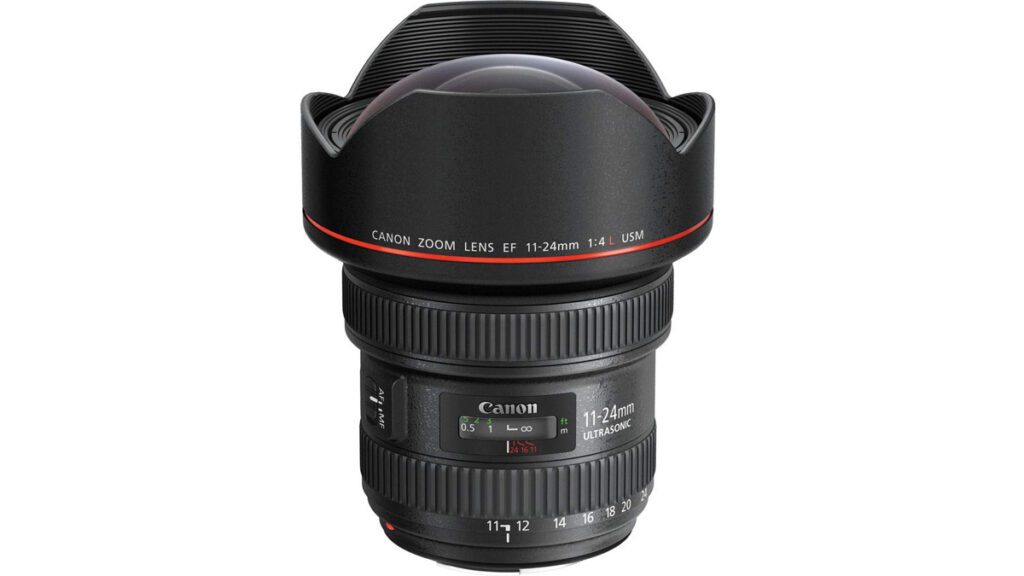
The Canon EF 11-24mm f/4L USM lens is a remarkable tool for real estate photography, embodying several key features that make it an excellent choice for professionals in this field. Let’s break down its features in relation to the must-have characteristics for real estate photography lenses:
- Wide-Angle Range: With a focal length range of 11-24mm, this lens offers an exceptionally wide field of view, making it ideal for capturing expansive interiors and architectural details. Its ability to shoot at 11mm is particularly useful in tight spaces, allowing for the capture of entire rooms or façades in a single shot.
- Minimal Distortion: Despite its ultra-wide angle, the Canon EF 11-24mm f/4L USM is designed to keep distortion to a minimum. This is crucial in real estate photography, where maintaining straight lines and accurate perspectives is essential. The lens’s optical design includes elements that help correct distortion and chromatic aberration.
- Sharpness: As part of Canon’s L series, this lens is built to deliver superior image quality. It provides excellent sharpness across the entire frame, from the center to the edges, even at the widest aperture. This level of detail is important for showcasing the textures and features of real estate properties.
- Autofocus Performance: The lens features a fast, silent, and accurate autofocus system. While manual focus might often be preferred for precise control in real estate photography, having reliable autofocus is beneficial for quick shots or when shooting in varying light conditions.
- Build Quality and Reliability: The EF 11-24mm f/4L USM is part of Canon’s Luxury (L) series, known for its high-quality construction and durability. It is built to withstand professional use in different environments, making it a reliable choice for real estate photographers who work in a variety of settings.
- Aperture: With a constant aperture of f/4, the lens provides consistent exposure across the entire zoom range. While f/4 might not be as wide as some other lenses, it is sufficient for real estate photography, where shooting with a tripod and longer exposures is common. The aperture also helps to keep the lens size manageable while still allowing for a significant amount of light.
- Image Stabilization: This lens does not feature built-in image stabilization. However, for the majority of real estate photography applications, where tripods are commonly used, this is not a significant drawback.
Final Answer:
The Canon EF 11-24mm f/4L USM lens is a premium choice for real estate photography, offering an unparalleled wide-angle range, minimal distortion, exceptional sharpness, and durable build quality. While it lacks image stabilization, this is typically not a limitation in the context of real estate photography. Its wide-angle capabilities and high-quality optics make it an excellent investment for professionals looking to capture detailed, expansive shots of properties.
2. Canon EF-S 10-18mm f/4.5-5.6 IS STM

The Canon EF-S 10-18mm f/4.5-5.6 IS STM is a lens that aligns well with the essential requirements for real estate photography, especially for those using Canon’s APS-C cameras. Here’s how it matches up against the must-have features for real estate photography lenses:
- Wide-Angle Range: The 10-18mm focal length is ideal for real estate photography, offering a wide field of view that’s perfect for capturing both interior spaces and expansive exteriors. On an APS-C camera, this range is equivalent to approximately 16-28.8mm in full-frame terms, ensuring you can get broad shots even in tight spaces.
- Minimal Distortion: This lens is designed to minimize distortion, which is a common issue with wide-angle lenses. Its optical design helps to keep lines straight and reduce the bowing effect that can otherwise distort architectural and interior photography.
- Sharpness: The EF-S 10-18mm f/4.5-5.6 IS STM is known for delivering good sharpness, especially in the center of the frame. Its performance in this area ensures that details in real estate photos are captured clearly, contributing to professional-quality images.
- Autofocus Performance: Equipped with STM (Stepping Motor) technology, this lens offers smooth, quiet, and precise autofocus. This feature is particularly beneficial when shooting video walkthroughs of properties, a common requirement in real estate marketing.
- Build Quality and Reliability: While this lens is not part of Canon’s L series and thus not built to the same rugged standards, it offers good build quality for its price point. It’s lightweight and easy to handle, making it a practical choice for extended real estate photography sessions.
- Image Stabilization: One of its standout features for real estate photography is the inclusion of image stabilization (IS), which allows for sharper images at slower shutter speeds. This is particularly useful in low-light conditions or when shooting without a tripod.
- Aperture: With a maximum aperture of f/4.5-5.6, this lens doesn’t offer the widest aperture settings compared to more expensive lenses. However, in the context of real estate photography, where deep depth of field and shooting on a tripod are common, this is not a significant limitation.
Final Answer:
The Canon EF-S 10-18mm f/4.5-5.6 IS STM lens is an excellent, budget-friendly option for real estate photography with APS-C cameras, offering a wide-angle range, minimal distortion, effective image stabilization, and precise autofocus. Its sharpness and optical quality are more than adequate for capturing detailed and expansive views of properties. While it may not have the build quality of higher-end L series lenses, its features and performance make it a valuable tool for real estate photographers looking for a lightweight and versatile lens.
3. Canon EF 16-35mm f/4L IS USM

The Canon EF 16-35mm f/4L IS USM lens is a high-performing, versatile option for real estate photography, especially suited to professionals using full-frame Canon DSLRs. Here’s an evaluation of its features against the critical needs for real estate photography:
- Wide-Angle Range: The 16-35mm focal length offers a broad field of view, crucial for capturing both the interiors and exteriors of properties. This range allows photographers to work in tight spaces without sacrificing the ability to capture expansive scenes.
- Minimal Distortion: As part of Canon’s L series, this lens is engineered to minimize distortion, which is vital for real estate photography where maintaining straight lines and accurate architectural details is essential. The optical design includes elements that effectively control distortion and chromatic aberrations.
- Sharpness: This lens delivers excellent sharpness across the entire frame, a hallmark of Canon’s L series lenses. The edge-to-edge clarity ensures that every detail of a property is captured crisply, from the textures of materials to the subtleties of design elements.
- Autofocus Performance: Equipped with an ultrasonic motor (USM), the EF 16-35mm f/4L IS USM lens provides fast, accurate, and silent autofocus. This feature is beneficial for quickly capturing high-quality images, although manual focus might often be preferred for precise adjustments in real estate photography.
- Build Quality and Reliability: The lens is built to the stringent standards of Canon’s L series, featuring robust construction and weather-sealing. This makes it a reliable choice for real estate photographers who face various environmental conditions while shooting different properties.
- Image Stabilization: One of the key features for real estate photography is its Optical Image Stabilization (IS), which compensates for camera shake. This allows for sharper images at slower shutter speeds, advantageous in low-light conditions or when shooting without a tripod.
- Aperture: With a constant aperture of f/4, the lens offers consistent exposure settings across the zoom range. While not as wide as some prime lenses, f/4 is adequate for real estate photography, where deep depth of field is often more critical than low-light performance.
Final Answer:
The Canon EF 16-35mm f/4L IS USM lens stands out as an exceptional choice for real estate photography on full-frame Canon cameras, thanks to its versatile wide-angle zoom range, minimal distortion, superior sharpness, and robust build quality. The inclusion of Optical Image Stabilization further enhances its suitability for this genre, ensuring sharp images even in challenging lighting conditions. Its performance and reliability make it a valuable tool for professionals seeking to capture detailed and expansive views of properties.
4. Canon 17mm f/4 L TS-E
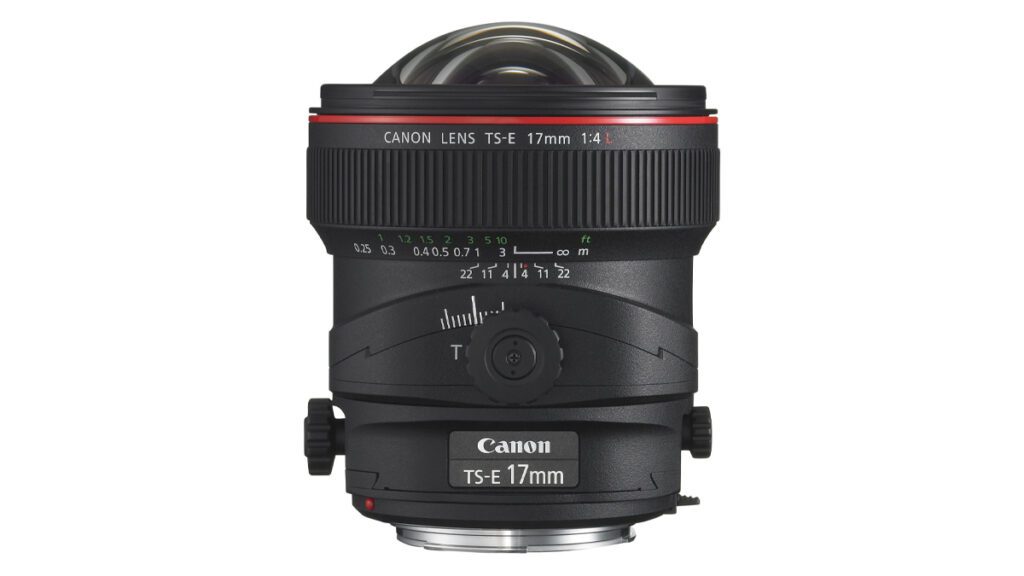
The Canon TS-E 17mm f/4L is a specialized tilt-shift lens, offering unique features that make it exceptionally well-suited for real estate and architectural photography. Let’s explore how it aligns with the essential requirements for real estate photography lenses:
- Wide-Angle and Perspective Control: The 17mm focal length provides an ultra-wide field of view, perfect for capturing expansive interior spaces and architectural details. The tilt-shift functionality allows for perspective control, enabling photographers to adjust the plane of focus and correct for vertical lines that appear to converge in architectural photography, a common issue when photographing tall buildings or interior spaces.
- Minimal Distortion: This lens is designed to offer minimal distortion, a critical feature for maintaining the straight lines and true geometries of architectural subjects. The precision with which this lens handles distortion makes it ideal for real estate photography, where accurate representation of spaces is crucial.
- Sharpness: The TS-E 17mm f/4L is renowned for its exceptional sharpness, even at the edges of the frame. This level of detail is vital for showcasing the textures and quality of real estate properties, ensuring that images appear crisp and detailed.
- Manual Focus and Movements: The lens features manual focus, which is standard for tilt-shift lenses. The manual tilt, shift, and rotation mechanisms provide unparalleled control over image composition and perspective, allowing for creative and technical adjustments that are not possible with standard lenses.
- Build Quality and Reliability: As part of Canon’s L series, the TS-E 17mm f/4L boasts superior build quality, with robust construction and weather-sealing. This makes it a durable option for the demanding conditions often encountered in real estate photography.
- Aperture: With a maximum aperture of f/4, the lens does not prioritize low-light performance but instead focuses on delivering consistent and high-quality output across its aperture range. In real estate photography, where lighting can be controlled or supplemented, and where depth of field is often more important, this aperture is perfectly adequate.
- Image Stabilization: The TS-E 17mm f/4L does not include image stabilization, which is typical for tilt-shift lenses. Given the precise nature of adjustments and the likelihood of using a tripod for architectural shots, the lack of IS is not generally a limitation in real estate photography.
Final Answer:
The Canon TS-E 17mm f/4L is an outstanding lens for real estate and architectural photography, distinguished by its ultra-wide angle of view, exceptional sharpness, and unique tilt-shift capabilities for perspective control. These features enable photographers to capture images with straight lines and accurate representations of space, essential for high-quality real estate photography. While it requires manual focus and does not have image stabilization, these aspects are consistent with the lens’s specialized use, making it a valuable tool for professionals aiming to produce top-tier architectural and real estate imagery.
5. Canon EF 85mm f/1.8 USM
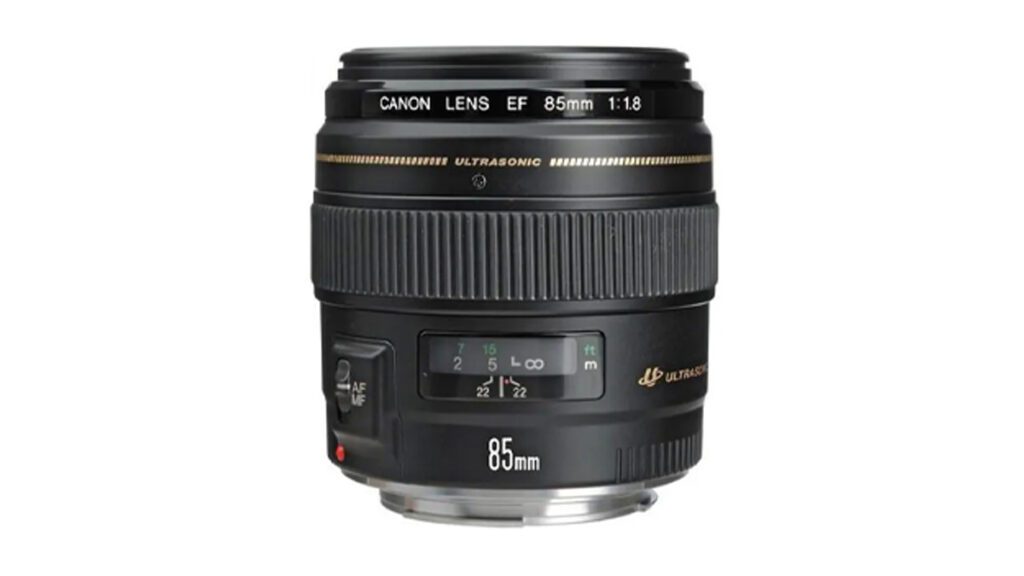
The Canon EF 85mm f/1.8 USM lens, while not typically classified as a traditional lens for real estate photography due to its telephoto focal length, possesses qualities that can be beneficial for specific aspects of real estate and architectural imaging. Here’s how it stands in relation to general real estate photography requirements:
- Focal Length: The 85mm focal length is considered telephoto on both full-frame and APS-C sensor cameras (equivalent to approximately 136mm on APS-C). This focal length does not provide the wide field of view needed for general interior or exterior shots in real estate photography. However, it can be useful for detail shots, highlighting specific features of a property, or for creating compressed perspective shots of exteriors from a distance.
- Aperture: With a wide maximum aperture of f/1.8, this lens excels in low-light conditions and can create a shallow depth of field, which is useful for emphasizing details or features within a property by blurring out distracting backgrounds.
- Sharpness: The EF 85mm f/1.8 USM is known for its excellent sharpness, even wide open at f/1.8. This sharpness improves further when stopped down slightly, making it capable of capturing high-detail images that can showcase the textures and quality of real estate features.
- Autofocus Performance: Equipped with an Ultrasonic Motor (USM), the lens offers fast, accurate, and quiet autofocus, beneficial for quickly capturing images without disturbing the ambiance of the space.
- Build Quality and Reliability: This lens is solidly built and offers good durability for professional use. However, it lacks the weather-sealing found in Canon’s L series lenses.
- Image Stabilization: The EF 85mm f/1.8 USM does not feature image stabilization. While IS can be beneficial in low-light conditions or for video work, the lens’s wide aperture somewhat compensates for this by allowing more light, enabling faster shutter speeds to be used to avoid camera shake.
- Portability: Its compact size and relatively light weight make it an easy lens to carry, providing flexibility without adding significant bulk to your gear.
Final Answer:
The Canon EF 85mm f/1.8 USM lens is primarily valued in portrait photography for its ability to deliver sharp images with a shallow depth of field and excellent low-light performance. In the context of real estate photography, it’s not a go-to choice for capturing wide interior or exterior shots due to its telephoto focal length. However, it can be exceptionally useful for detail shots, allowing photographers to isolate and emphasize specific features of a property with a pleasing background blur. Its sharpness, fast aperture, and autofocus performance make it a valuable supplementary lens for real estate photographers looking to add creative detail shots to their portfolio.
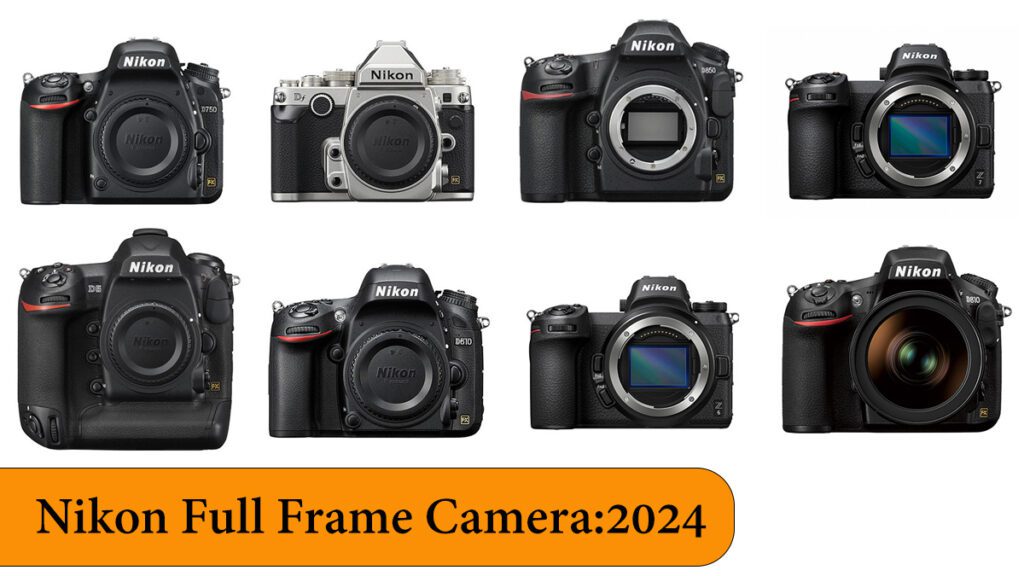
conclusion
In conclusion, selecting the right lens for real estate photography depends on the specific needs of the shoot, the type of camera being used (full-frame or APS-C), and the desired outcome of the photographs. Wide-angle lenses, such as the Canon EF 11-24mm f/4L USM for full-frame cameras and the Canon EF-S 10-18mm f/4.5-5.6 IS STM for APS-C cameras, are essential for capturing expansive interior and exterior shots, providing minimal distortion, and ensuring sharpness across the frame.
Specialized lenses like the Canon TS-E 17mm f/4L offer unique tilt-shift capabilities for perspective control, making them invaluable for architectural photography, where straight lines and accurate representations are paramount.
Telephoto lenses like the Canon EF 85mm f/1.8 USM, while not typical for wide shots in real estate photography, serve a specialized role in highlighting property details, offering a shallow depth of field, and performing well in low light.
Each lens brings specific advantages to real estate photography:
- Wide-angle lenses capture the breadth and depth of spaces, essential for showcasing properties.
- Tilt-shift lenses provide control over perspective and composition, vital for architectural accuracy.
- Telephoto lenses excel in capturing details and creating focused compositions that highlight features of a property.
The choice of lens should align with the photographer’s intention to either convey the spaciousness of a property, correct architectural distortions, or highlight unique details. The selection of equipment should be guided by the need to produce high-quality images that accurately and attractively represent real estate, catering to the visual demands of potential buyers or tenants.
